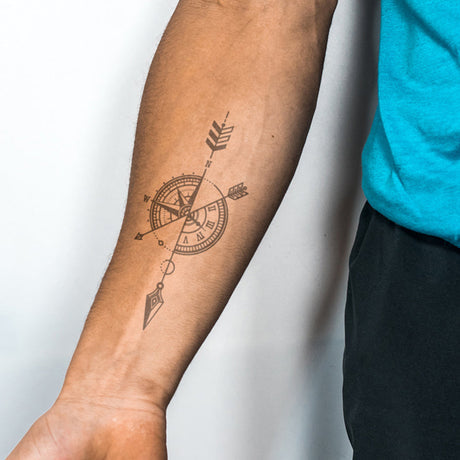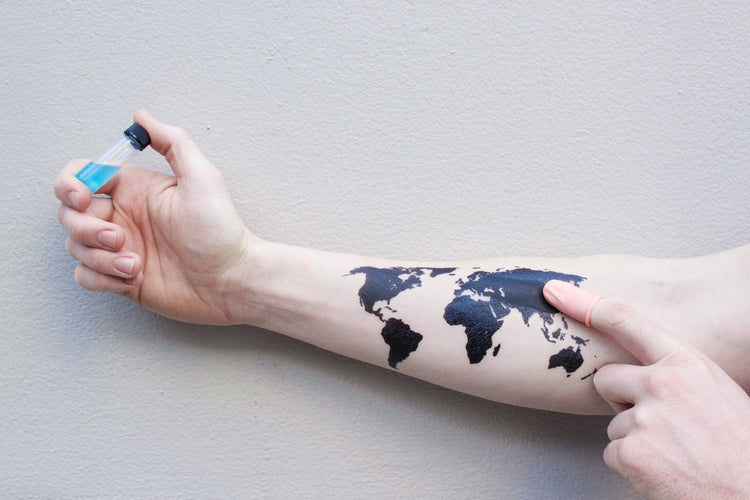
How do Temporary Tattoos Work?
Temporary tattoos are everywhere. From kids’ goodie bags at birthday parties to customized designs, temporary body art has many forms. While temporary tattoos don’t inject ink under your skin, they’re more than just a sticker for your arm. Here’s an inside look at how they work and more.
How temporary tattoos are made
Temporary tattoos are composed of layers that help the design adhere to your skin. Most temporary tattoos contain backing paper, silicone release coating, and transfer film. The silicone release coating helps transfer the design to the skin, and the transfer film allows the image to come off the paper fully when moisture is applied.
The temporary tattoo contains ink and adhesive. The ink that makes up a temporary tattoo can last up to a week when properly cared for, and because it sits on the skin, it has to meet safety standards. The adhesive helps ensure the design stays on the skin.
Temporary tattoos that you purchase come on paper with transfer film. Some people prefer to draw their temporary tattoos themselves and use permanent markers or tools made to draw on the skin. Henna tattoos use a special ink paste, which differs from what’s used in permanent markers or temporary tattoo pens.
Ink: Because temporary tattoos go onto the skin, the ink in them must meet FDA requirements. They can also include drying agents or extenders that influence how quickly the design dries and how long it lasts on the skin.
Colorants and/or polymers: Some temporary tattoos contain polymers or colorants. These items must also meet FDA standards to be included in a temporary tattoo.
Paper or film: Most temporary tattoos are printed on backing paper, but some are printed on plastic film or a combination of both.
Are Temporary Tattoos Safe?
In most cases, temporary tattoos are safe. However, if you notice skin blisters, loss of pigmentation, redness, lesions, or increased sensitivity after you’ve applied a temporary tattoo, you should seek medical care. These issues may not appear immediately but two or three weeks after applying the tattoo.
A note about black henna: Traditional henna tattoos contain dried, crumbled henna plants made into a paste. This ink is safe for skin application and almost always yields a red/brown color.
Black henna, on the other hand, is not. Black henna is made from artificial ingredients like paraphenylenediamine or PPD. PPD is usually in dark hair dyes and can cause allergic reactions in some people. It can also be absorbed through the skin and cause other serious issues.
Temporary tattoos sold in the United States must meet the same FDA regulations as cosmetics, so temporary tattoos are safe for most people. If you purchase temporary tattoos from other countries, their ingredients may not be regulated like in the US and they may cause skin reactions.
Henna tattoos are generally safe as long as they don’t include PPD. Airbrush tattoos, a form of temporary tattoo, are also generally safe because they must adhere to the same safety regulations as transfer tattoos.
If you have sensitive skin, skin conditions, or irritated or broken skin, it may not be a good idea to use temporary tattoos.
How Long Do Temporary Tattoos Last?
With proper care, most temporary tattoos last between three to five days. This includes airbrush tattoos. If you want your temporary tattoo to last as long as possible, be sure to apply it to clean, dry skin. Make sure the area where you apply the tattoo does not receive a lot of friction from clothes or other organs and does not frequently flex.
Is There a Temporary Tattoo that Lasts a Long Time?
You may have a temporary tattoo design that you’d like to keep on your skin for as long as possible. But, because the temporary tattoo design sits on top of your skin, there’s no way to extend its life beyond a week or two.
If you want a longer-lasting tattoo design than typical temporary tattoos, tattoo pens can provide longer-lasting art that lasts from 2-4 weeks. Henna tattoos can last anywhere from a few days to a week. Semi-permanent tattoos last one to two weeks. There’s really no temporary tattoo that lasts months or even a year.
If you want to extend the life of your temporary tattoo, you can try applying hairspray, makeup primer, or liquid bandage over your design. Also, be sure to avoid scrubbing the tattoo area and try to avoid excessive sweating in that area.
Temporary tattoos made and sold in the United States are safe, thanks to adherence to FDA regulations. However, if you have sensitive skin, a skin condition, or open wounds, avoid applying temporary tattoos. If you’re going to get henna tattoos or any other tattoos that use dark ink, be sure they don’t contain PPD.




